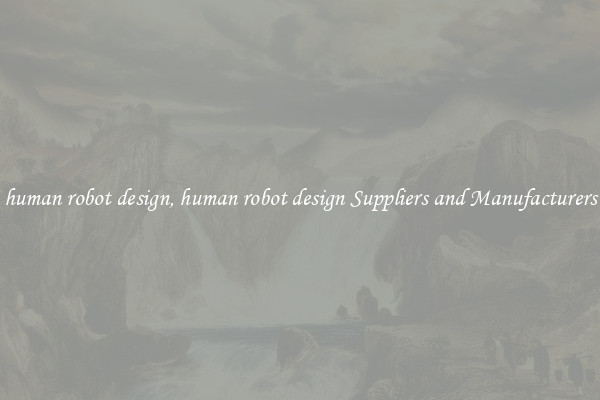human robot design, human robot design Suppliers and Manufacturers
In recent years, there has been a significant advancement in human robot design. With the rapid development of technology, robots are becoming more human-like in appearance and functionality. These humanoid robots are designed to mimic human movements and gestures, making them more relatable and capable of performing complex tasks.

One of the key players in human robot design are the suppliers and manufacturers who provide the necessary components and expertise to make these robots a reality. These suppliers and manufacturers play a crucial role in the development and production of human-like robots by providing advanced sensors, actuators, artificial intelligence algorithms, and other essential technologies.
One of the important aspects of human robot design is the development of realistic physical features. Suppliers and manufacturers use advanced materials and technologies to create robots that closely resemble the human body. This includes the design and fabrication of realistic skin, facial features, and even hair. By achieving a high level of resemblance to humans, these robots can interact with individuals in a more natural and intuitive manner.
Another crucial element in human robot design is the incorporation of sophisticated motion control systems. Suppliers and manufacturers work towards developing robotic systems that can replicate human movements accurately. This involves the integration of intricate actuators and servo motors that enable smooth and precise robotic motions. By mimicking human gestures and movements, humanoid robots can perform tasks that require dexterity and precision, such as handling delicate objects or performing complex surgery.
Suppliers and manufacturers also focus on the development of advanced artificial intelligence algorithms for humanoid robots. These algorithms enable robots to process information, interpret human gestures, understand emotions, and even learn from their surroundings. By combining artificial intelligence with human-like physical features, these robots can interact with humans in a more personalized and responsive manner.
Additionally, suppliers and manufacturers are continuously working towards improving the safety features of human-like robots. This includes the development of robust sensor systems that allow robots to detect and avoid obstacles, as well as ensuring that robots possess the necessary programming to interact safely with humans. By prioritizing safety, manufacturers are making humanoid robots suitable for use in various domains, including healthcare, customer service, and even domestic environments.
In conclusion, the field of human robot design has made remarkable progress in recent years. Suppliers and manufacturers are at the forefront of this advancement by providing the necessary components and expertise to create realistic and functional humanoid robots. With continued innovation, these human-like robots have the potential to revolutionize industries and improve human lives by performing tasks that were previously challenging or even impossible for traditional robots.

View details

View details

View details

View details








